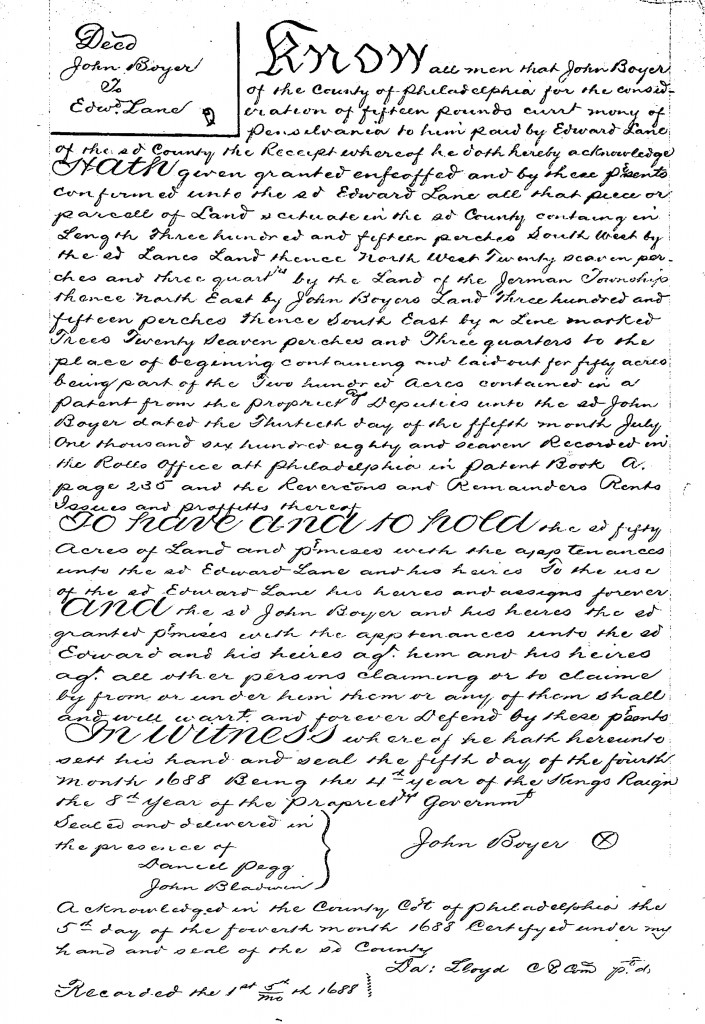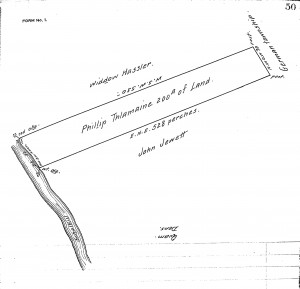Every genealogist and family historian faces the task of identifying people in records. Identifying the people on Holme’s map is no different. In the end, each person in the past is no more than a collection of records. All that is left of Walter Bridgman’s life in Pennsylvania is 21 records: he immigrated from Cornwall, married Blanche Constable by approval of Middletown Monthly Meeting, owned land, signed a paper against selling rum to the Indians, died, left a daughter. Unless a descendant somewhere has an heirloom, that is the sum total of the material we have for Walter. He is typical of many of the people on Holme’s map—the records form a straightforward pattern that fits one and only one person.
Some of the people on the map were prominent—they served in the government or were personal friends of Penn or otherwise left substantial evidence of their lives. Men like John Bevan, Thomas Lloyd, John Simcock, Christopher Taylor and James Harrison do not need to be identified; they are historical figures who in a sense have already been identified. About a hundred of the names on the map fall into this category and required little research.
Another group of people were not prominent, yet left records that formed a pattern, people like Walter Bridgman. Given the population involved here, we would expect to find an emigration record, land purchase, membership in a Quaker meeting, marriage and death. When we find these records for someone, with a name that is probably unique, and where the records fit into a location matching the tract on the map, then we can assume we’ve found a person. This is the largest group of people on the map—it required research to find them, digging into the records, yet the records when found formed a recognizable pattern. There are several hundred people like this on the map, famous only to their descendants, people like John Jennet, Mary Bradwell, Luke Hank, Michael Isard and Thomas Groom.
Some people on the map posed problems: names radically different from the one on the map, two men with the same name, records that don’t form a neat pattern, people who lived quietly and left few records. These required more research and more evaluation of the evidence.
For example, who were the widow Bond, John Bye, Drawell, Daniel Hough, and John Swart? With some research, these were found to be the widow of John Bond, the First Purchaser John Boy, Joseph Drake the 1683 emigrant, John Hough of Darby (not Daniel), and Jan Classen the horse trader who was known by different names. About fifty of the people on the map required this extra level of analysis.
That leaves a few genuine puzzles: names that don’t match any known records. We have to assume that these were errors, either by Holme or by the engraver in London who had no personal knowledge of the people. There are five of them: John Denne, John Eluny, Free School, Widdow, and William Jones. John Denne is shown on the map in Whitpain township with John Goodson. There were several men around named John Dennison or Denning or Densey, but none of them can be tied to this land in Whitpain or to the physician John Goodson. John Eluny is shown in Westtown next to Francis Yarnall; there are no records of any Eluny at the time, and no land records that give a clue who this might be. The tract marked Free School is in Chester Township. There are no records of land being set aside for a school at this time. The only owner near there was Richard Few, so perhaps this was an error for his name. Widdow is on the map in Edgmont. When Holme showed the land of a widow he always included her surname, for example the widow Hurst or the widow Shorter. There was a William Findlow who bought land in Edgmont in 1687, but this seems late to make it onto the map, though it was in about the right place. Finally, there is the problem of William Jones. There were men around named William Jones, but none of them can be tied to this land in Newtown. Smith’s Atlas of Delaware County shows this land as belonging to Robert Dunton. Did one of the men named William Jones acquire the land from Dunton? These are puzzles that cannot be answered yet, possibly not at all, given available records.



